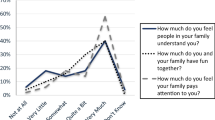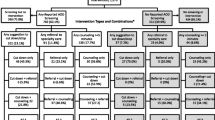Abstract
Homeless and runaway youth are at disproportionate risk for adverse health outcomes. Many barriers to accessing healthcare have been documented; however, the relative impact of discrete barriers on homeless youth healthcare utilization behavior is not firmly established. We administered a survey examining reported barriers and healthcare utilization among adolescents and young adults accessing services at three community centers for homeless and runaway youth. Of 180 respondents, 57 % were male, 80 % non-White, and 21 % identified as a sexual minority. Stepwise logistic regression models, controlling for age and study site, explored associations between barriers and 3 healthcare utilization outcomes (doctor visit in past 12 months; regular care provider; frequent emergency department (ED) visits). The most commonly reported barriers were “don’t have a ride” (27.2 %), “no insurance” (23.3 %), and “costs too much” (22.8 %). All fear-based barriers (e.g., “I don’t trust the doctors”) were reported by <5 % of surveyed youth. Significant predictors of having seen a doctor in the past 12 months included sexual minority status (OR 2.8, p = 0.04) and possession of health insurance (OR 4.9, p < 0.001). Female sex (OR 5.2, p < 0.001) and reported external barriers other than health insurance (OR 0.2, p < 0.001) were associated with having a regular care provider. Fear-based concerns were associated (OR 3.8, p = 0.02) with frequent ED visits, as was being insured (OR 2.2, p = 0.03). These results underscore the need to clearly define healthcare outcomes when investigating barriers to care among homeless and runaway youth as the impact of discrete barriers varies depending on outcome of focus.


Similar content being viewed by others
References
Burt, M. (Ed.). (2007) Understanding homeless youth: numbers, characteristics, multi-system involvement, and intervention options. Testimony given before the U.S. House Committee on Ways and Means, subcommittee on Income Security and Family Support, June 19, 2007. Urban Institute.
Ensign, J., & Bell, M. (2004). Illness experiences of homeless youth. Qualitative Health Research, 14(9), 1239–1254.
Feldmann, J., & Middleman, A. B. (2003). Homeless adolescents: Common clinical concerns. Seminars in Pediatric Infectious Diseases, 14(1), 6–11.
Klein, J. D., Woods A. H., Wilson, K. M., Prospero, M., Greene, J., & Ringwalt, C. (2000). Homeless and runaway youths’ access to health care. Journal of Adolescent Health, 27(5), 331–339.
Lebrun-Harris, L. A., Baggett, T. P., Jenkins, D. M., et al. (2013). Health status and health care experiences among homeless patients in federally supported health centers: Findings from the 2009 patient survey. Health Services Research, 48(3), 992–1017.
Ensign, J., & Panke, A. (2002). Barriers and bridges to care: Voices of homeless female adolescent youth in Seattle, Washington, USA. Journal of advanced nursing, 37(2), 166–172.
Ensign, J., & Gittelsohn, J. (1998). Health and access to care: Perspectives of homeless youth in Baltimore City, USA. Social Science & Medicine (1982), 47(12), 2087–2099.
Hagedorn, S. (2002). Caring for street youth: A nursing challenge. Journal for Specialists in Pediatric Nursing: JSPN, 7(1), 34–37.
Little, M., Gorman, A., Dzendoletas, D., & Moravac, C. (2007). Caring for the most vulnerable: A collaborative approach to supporting pregnant homeless youth. Nurs. Women’s Health (London, England), 11(5), 458–466.
Thomas, N., Murray, E., & Rogstad, K. E. (2006). Confidentiality is essential if young people are to access sexual health services. International Journal of STD and AIDS, 17(8), 525–529.
Rubin, S. E., McKee, M. D., Campos, G., & O’Sullivan, L. F. (2010). Delivery of confidential care to adolescent males. The Journal of the American Board of Family Medicine, 23(6), 728–735.
Elliott, B. A., & Larson, J. T. (2004). Adolescents in mid-sized and rural communities: Foregone care, perceived barriers, and risk factors. Journal of Adolescent Health, 35(4), 303–309.
Lim, S. W., Chhabra, R., Rosen, A., Racine, A. D., & Alderman, E. M. (2012). Adolescents’ views on barriers to health care: A pilot study. Journal of Primary Care & Community Health, 3(2), 99–103.
Christiani, A., Hudson, A. L., Nyamathi, A., Mutere, M., & Sweat, J. (2008). Attitudes of homeless and drug-using youth regarding barriers and facilitators in delivery of quality and culturally sensitive health care. Journal of Child and Adolescent Psychiatric Nursing, 21(3), 154–163.
Darbyshire, P., Muir-Cochrane, E., Fereday, J., Jureidini, J., & Drummond, A. (2006). Engagement with health and social care services: Perceptions of homeless young people with mental health problems. Health & social care in the community, 14(6), 553–562.
Nickasch, B., & Marnocha, S. K. (2009). Healthcare experiences of the homeless. Journal of the American Academy of Nurse Practitioners, 21(1), 39–46.
Farrow, J. A., Deisher, R. W., Brown, R., Kulig, J. W., & Kipke, M. D. (1992). Health and health needs of homeless and runaway youth. A position paper of the Society for Adolescent Medicine. Journal of Adolescent Health, 13(8), 717–726.
Slesnick, N. (2014). The forgotten children: Unaccompanied runaway and homeless youth [White paper]. Columbus: Crane Center for Early Childhood Research and Policy, The Ohio State University.
Hernandez-Boussard, T., Burns, C. S., Wang, N. E., Baker, L. C., & Goldstein, B. A. (2014). The Affordable Care Act reduces emergency department use by young adults: Evidence from three States. Health Affairs, 33(9), 1648–1654.
Hernandez-Boussard, T., Morrison, D., Goldstein, B. A., & Hsia, R. Y. (2016). Relationship of affordable care act implementation to emergency department utilization among young adults. Annals of Emergency Medicine, 714–720(6), e711.
Bharel, M., Lin, W. C., Zhang, J., O’Connell, E., Taube, R., & Clark, R. E. (2013). Health care utilization patterns of homeless individuals in Boston: Preparing for Medicaid expansion under the Affordable Care Act. American Journal of Public Health, 103(Suppl 2), S311–S317.
Goepp, J. G., Chin, N. P., Massad, J., & Edwards, L. A. (2004). Pediatric emergency department outreach: Solving medical problems or revealing community solutions? Journal of Health Care for the Poor and Underserved, 15(4), 522–529.
Chin, N. P., Goepp, J. G., Malia, T., Harris, L., & Poordabbagh, A. (2006). Nonurgent use of a pediatric emergency department: A preliminary qualitative study. Pediatric Emergency Care, 22(1), 22–27.
Dawson, A., & Jackson, D. (2013). The primary health care service experiences and needs of homeless youth: A narrative synthesis of current evidence. Contemporary Nurse, 44(1), 62–75.
Williams, K. A., & Chapman, M. V. (2011). Comparing health and mental health needs, service use, and barriers to services among sexual minority youths and their peers. Health and Social Work, 36(3), 197–206.
Acknowledgments
The authors would like to thank the staff and youth at Star House and Huckleberry House for their assistance and participation in this project.
Funding
This work was funded by The Ohio State University Center for Clinical and Translational Science (CCTS), CTSA Grant Number UL1TR001070. The content of this manuscript is solely the responsibility of the authors and does not necessarily represent the official views of OSU CCTS.
Author information
Authors and Affiliations
Corresponding author
Rights and permissions
About this article
Cite this article
Chelvakumar, G., Ford, N., Kapa, H.M. et al. Healthcare Barriers and Utilization Among Adolescents and Young Adults Accessing Services for Homeless and Runaway Youth. J Community Health 42, 437–443 (2017). https://doi.org/10.1007/s10900-016-0274-7
Published:
Issue Date:
DOI: https://doi.org/10.1007/s10900-016-0274-7




